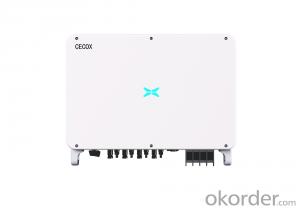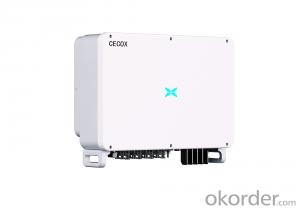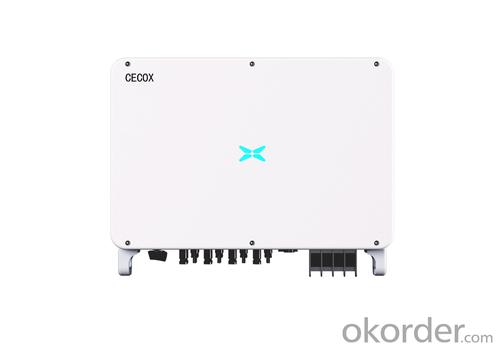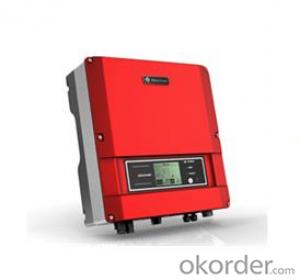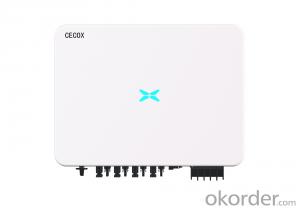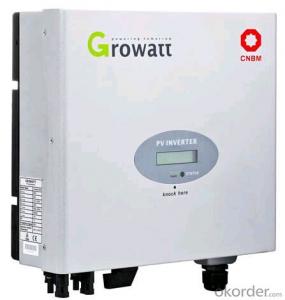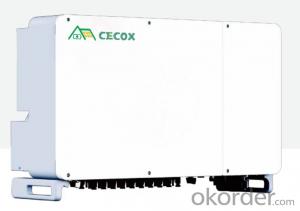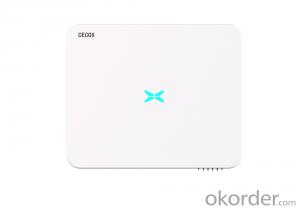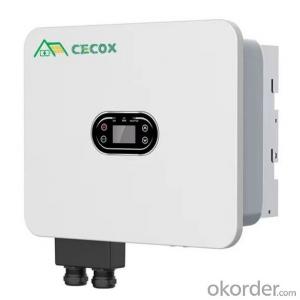3kVA Solar Inverter - 50kw 60kw 66kw 70kw Three Phase On-Grid Solar Inverter
- Loading Port:
- SHENZHEN
- Payment Terms:
- TT OR LC
- Min Order Qty:
- 30 unit
- Supply Capability:
- 500 unit/month
OKorder Service Pledge
OKorder Financial Service
You Might Also Like
Specification
XG50kW-70kW
Three Phase On-Grid Solar Inverter
XG50KTR | XG50KTRL | XG60KTR | XG60KTRL | XG66KTRL | XG70KTRL | |
Input(DC) | ||||||
Max. Input Power | 80 kW | 96 kW | 105.6kW | 112kW | ||
Max. Input Voltage | 1100V | |||||
Start Voltage | 250V | |||||
Rated Input Voltage | 600V | 700V | ||||
Full-load MPP Voltage Range | 520V-850V | 600V-850V | ||||
MPPT Voltage Range | 200V-1000V | |||||
Number of MPP Trackers | 4 | |||||
Number of string per MPPT | 3/2/3/2 | 3/3/3/3 | ||||
Max.Current per MPPT | 39A/26A/39A/26A | 39A | ||||
Max.Short Circuit Current per MPPT | 48A/32A/48A/32A | 48A | ||||
Output(AC) | ||||||
Max. Output Current | 79.7 A | 66.2 A | 95.6 A | 79.4 A | 87.4A | 96.2A |
Rated Output Power | 50 kW | 60 kW | 66kW | 70kW | ||
Max. Output Power | 55 kVA | 66kVA | 72.6kVA | 77kVA | ||
Rated Grid Frequency | 50 Hz / 60 Hz | |||||
Rated Grid Voltage | 230Vac / 400Vac | 277Vac / 480Vac | 230Vac / 400Vac | 277Vac/480Vac | ||
Power Factor | >0.99 (0.8 leading~0.8 lagging) | |||||
THDi | <3% (Rated Power) | |||||
Efficiency | ||||||
Max. Efficiency | 98.70% | 98.80% | ||||
European Efficiency | 98.40% | 98.50% | ||||
MPPT Efficiency | 99.90% | |||||
Protection | ||||||
DC reverse polarity protection | Yes | |||||
Anti-Islanding protection | Yes | |||||
AC short circuit protection | Yes | |||||
Residual current monitoring unit | Yes | |||||
Insulation resistance monitoring | Yes | |||||
Ground fault monitoring | Yes | |||||
Grid monitoring | Yes | |||||
PV string monitoring | Yes | |||||
Surge protection | Type II | |||||
AFCI protection | Optional | |||||
Communication | ||||||
Display | LED / LCD / WiFi+App | |||||
Communication | Standard:RS485 Optional:WiFi / GPRS / Ethernet | |||||
Standard Compliance | ||||||
Grid Connection Standards | IEC 61727, IEC 62116, IEC 60068, IEC 61683, VDE-AR-N 4110:2018, VDE-AR-N 4105:2018, VDE-AR-N 4120:2018, EN 50549, AS/NZS 4777.2:2020, CEI 0-21, VDE 0126-1-1/A1 VFR2014, UTE C15-712-1:2013, DEWA DRRG, NRS 097-2-1, MEA/PEA, C10/11, G98/G99 | |||||
Safety/EMC | IEC 62109-1:2010, IEC 62109-2:2011, EN 61000-6-2:2005, EN 61000-6-3:2007/A1:2011 | |||||
General Data | ||||||
Dimensions (W*H*D) | 650 x 450 x 260 mm | |||||
Weight | 50 kg | |||||
Operating Temperature Range | -30° C ~ +60° C | |||||
Cooling Method | Smart Cooling | |||||
Protection Degree | IP66 | |||||
Max. Operating Altitude | 4000 m | |||||
Relative Humidity | 0 ~ 100% | |||||
Topology | Transformerless | |||||
Night Power Consumption | < 1 W | |||||
MARKETING & SERVICE NETWORK
CNBM global sales team provides customers with professional and efficient pre-sale,
in sale and after-sale services, and enhances the added value of the brand with high-quality services.
Products Details:
High voltage protection Over load protection
Battery reverse connected protection Dust-proof
Low voltage protection Overheating protection
Output short-circuit protection Insect prevention
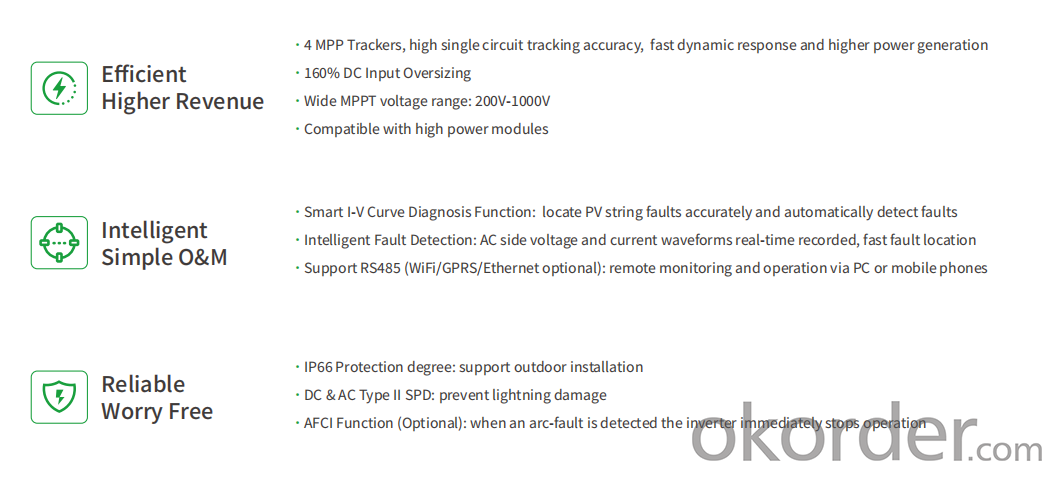
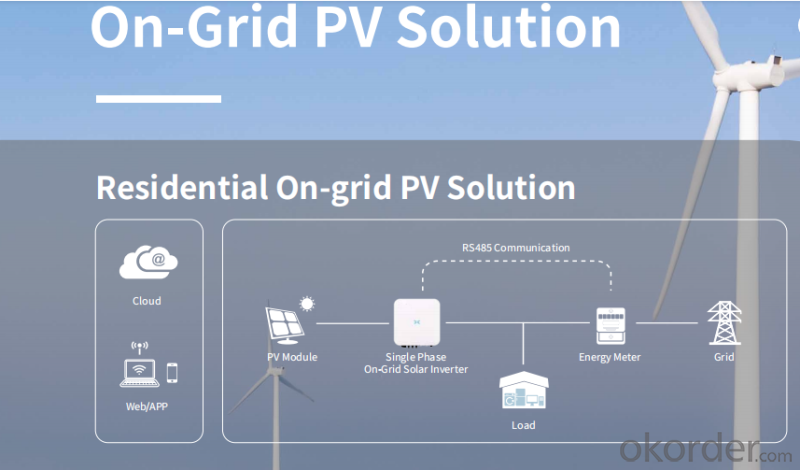
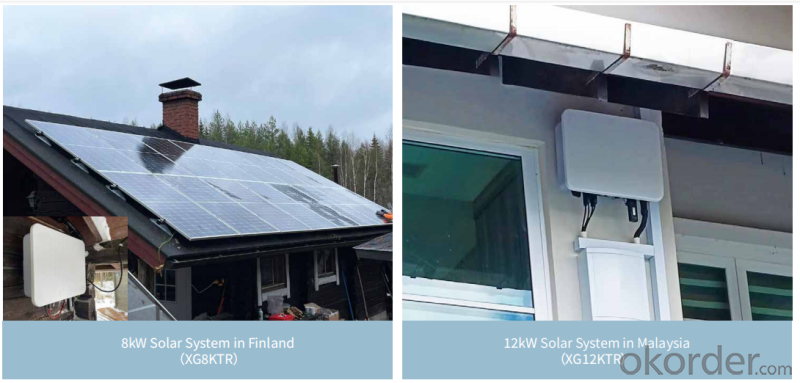


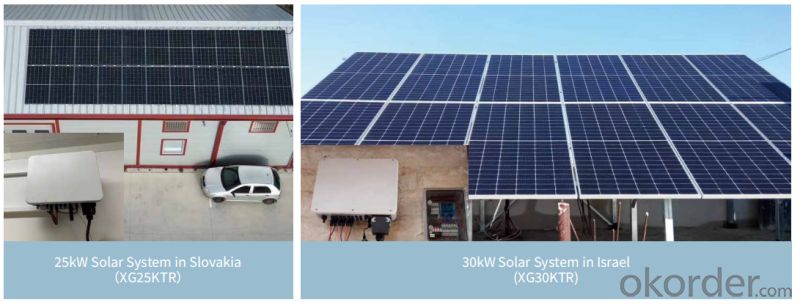
FAQ:
Q1:May I take some samples to test before placing the order ?
A1:Yes, welcome to take some sample to test!
Q2:How about the delivery time?
A2:7 days for sample; 25 days for bulk order.
Q3:What is the warranty of the controller?
A3:1 years warranty.
Q4:How to solve the technical problems?
A4:24 hours after-service consultancy just for you and to make your problem to be solved easily.
Q5:What payment methods do your company support?
A5:T/T, Western Union, Paypal, L/C etc.
Q6:What are the price terms can you offer for us?
A6:We can accept EXW, FOB, CIF and so on.
Q7:Do you have any certifications for your products?
A7:We have ISO9001:2000, CE, RoHS, certificates for all of our products.
- Q: How do you calculate the efficiency of a solar inverter?
- To calculate the efficiency of a solar inverter, you need to divide the output power by the input power and multiply the result by 100 to get a percentage. The formula is: Efficiency = (Output Power / Input Power) * 100.
- Q: Can a solar inverter be used with a remote monitoring system?
- Yes, a solar inverter can be used with a remote monitoring system. In fact, many modern solar inverters are designed to be compatible with remote monitoring systems. This allows users to monitor the performance and output of their solar system from a remote location, providing real-time data on energy production, system efficiency, and any potential issues or faults. Remote monitoring systems provide convenience, enable proactive maintenance, and help optimize the overall performance of solar installations.
- Q: What is the role of a transformer in a solar inverter?
- The role of a transformer in a solar inverter is to convert the direct current (DC) power generated by the solar panels into alternating current (AC) power that can be used by household appliances and fed back into the electrical grid. The transformer helps to step up or step down the voltage as necessary and provides isolation between the solar panels and the grid, ensuring safe and efficient power transmission.
- Q: What is the impact of a solar inverter on the overall system cost?
- The overall system cost can be significantly impacted by a solar inverter. An essential component of a solar power system, the solar inverter converts the direct current (DC) generated by solar panels into alternating current (AC) for powering electrical devices or feeding back into the grid. The cost of a solar inverter varies based on its capacity, efficiency, and brand. Generally, more advanced and efficient inverters tend to be pricier. However, investing in a high-quality inverter can lead to long-term savings and improved system performance. Considering the size of the solar power system is important. Inverters have capacity limits, so selecting the right-sized inverter is crucial for optimizing energy production and system efficiency. An undersized inverter can restrict performance, while an oversized one may result in unnecessary additional costs. The quality and reliability of the inverter are also significant factors. A well-built and reliable inverter can minimize maintenance and repair expenses, ensuring a longer lifespan for the solar power system. Furthermore, advanced features like monitoring capabilities and grid integration functionalities can enhance system performance and provide valuable maintenance and troubleshooting data, though they may increase overall system cost. Additionally, the efficiency of a solar inverter can impact the overall system cost. Higher efficiency inverters can convert more DC power into usable AC power, increasing energy production and potentially reducing the number of required solar panels. This can result in cost savings in terms of panel purchase and installation. In conclusion, while the cost of a solar inverter is an important factor in overall system cost, it is crucial to balance it with considerations such as capacity, efficiency, reliability, and additional features. Investing in a properly sized, high-quality inverter can lead to long-term savings, improved system performance, and higher energy production, maximizing the value and benefits of a solar power system.
- Q: Can a solar inverter be connected to a backup battery system?
- Yes, a solar inverter can be connected to a backup battery system. This allows the solar energy generated during the day to be stored in the backup battery system and used during times when the sun is not shining or during power outages.
- Q: How is the output voltage and frequency of a solar inverter regulated?
- The output voltage and frequency of a solar inverter are regulated through a combination of control algorithms and power electronics. These control algorithms constantly monitor and adjust the voltage and frequency based on the energy generated by the solar panels and the power requirements of the connected load. The power electronics, such as voltage regulators and frequency converters, ensure that the output voltage and frequency remain within the desired range. This regulation is crucial to provide stable and consistent power to the electrical grid or the connected devices.
- Q: What are the key factors affecting the reliability of a solar inverter?
- The key factors affecting the reliability of a solar inverter include the quality and durability of its components, such as the semiconductor devices, capacitors, and transformers. The design and manufacturing processes also play a significant role, as well as the overall system integration and installation. The environmental conditions, such as temperature, humidity, and dust levels, can impact the inverter's reliability, along with the quality of the electrical grid and the stability of the solar power generation. Regular maintenance and monitoring are crucial for identifying and addressing any potential issues that may arise, ensuring the long-term reliability of the solar inverter.
- Q: Can a solar inverter be used with different types of communication interfaces?
- Yes, a solar inverter can be used with different types of communication interfaces. Many modern solar inverters are designed to be compatible with various communication protocols such as Wi-Fi, Ethernet, RS485, and Zigbee. This allows for easy integration and monitoring of the inverter with different types of communication systems and devices.
- Q: What safety features should a solar inverter have?
- A solar inverter should have several safety features to ensure reliable and secure operation. These features may include overvoltage and undervoltage protection, ground fault protection, temperature monitoring, short circuit protection, and anti-islanding protection. Additionally, it should have built-in surge protection and be compliant with relevant safety standards to safeguard the system and prevent any potential hazards.
- Q: What is the role of isolation in a solar inverter?
- The role of isolation in a solar inverter is to provide safety and protect the user from electrical shocks. It separates the input and output sides of the inverter, ensuring that any faults or disturbances on one side do not affect the other. Isolation also helps to minimize electrical noise and interference, improving the overall performance and reliability of the solar inverter.
Send your message to us
3kVA Solar Inverter - 50kw 60kw 66kw 70kw Three Phase On-Grid Solar Inverter
- Loading Port:
- SHENZHEN
- Payment Terms:
- TT OR LC
- Min Order Qty:
- 30 unit
- Supply Capability:
- 500 unit/month
OKorder Service Pledge
OKorder Financial Service
Similar products
Hot products
Hot Searches
Related keywords
